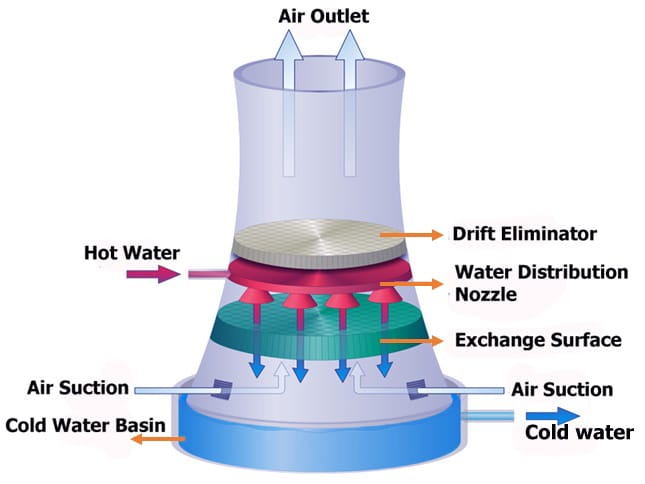Natural draft cooling tower is made from concrete in a hyperbolic shape which are enabled to obtain air flow through chimney effect. This type of towers is mostly used in power stations.
Principle of Natural Draft Cooling Tower
Hot water from the system is cooled through direct contact with fresh air. This increases the temperature and humidity of the air in the tower. Warm and moist air is less dense, which causes it to moves out of the tower into the atmosphere and draw in denser fresh air. The difference between the warm air inside the tower and the cooler air outside creates the perfect air flow.
Working of Natural Daft Cooling Tower

The incoming hot water that needs cooling in tower is pumped through hot water inlet. The inlet is connected to spray nozzles that spray the water over the entire fill material, which provides a large surface area for heat transfer.
At the bottom of the tower, the structure is open to draw in fresh air, which then flows upward and allows for direct contact heat transfer between the warm water and the air.
The hot water releases heat after coming into direct contact with the fresh air, and some of the hot water is evaporated. Cold water is collected at the bottom of the tower. Warm and moist air is discharged from the top of the tower into the atmosphere.
The air exiting the top of the tower draws in more air at the base of the tower, creating a natural air flow from the base to the top of the tower.
Stack Effect or Chimney Effect
When air is heated, it becomes less dense. Because warm air is less dense than cold air, it will rise above cold air due to the density difference. This process of warm and cold air separating based upon densities is known as the chimney effect.
Components of Natural Draft Cooling Tower
- Collecting Basin or Reservoir
- Distribution System
- Sump
- Fill
- Drift Eliminator
- Hyperboloid Tower
- Spray Nozzle
- Cooling water outlet
- Cooling water inlet
Natural Draft Head
The natural draft head can be calculated as:
dhmmH2O = 1000 h (ρo – ρr) / ρh2o
where
dhmmH2O = head in millimeter water column (mm H2O)
ρo = density outside air (kg/m3)
ρr = density inside air (kg/m3)
ρh2o = density water (in general 1000 kg/m3)
h = height between outlet and inlet air (m)
Natural Draft Pressure
The natural draft pressure can be calculated as:
dp = g (ρo – ρr) h
where
dp = pressure (Pa, N/m2)
g = acceleration of gravity = 9.81 (m/s2)
Density and Temperature
The density can be calculated as:
With air density 1.293 kg/m3 at 0oC – the air density at any temperature can be expressed as
ρ = (1.293 kg/m3) (273 K) / (273 K + t)
or
ρ = 353 / (273 + t) (2b)
where
ρ = density of air (kg/m3)
t = the actual temperature (oC)
Advantages of Natural Draft CT
- Low noise level.
- Low maintenance costs as there are no fans used.
- System losses is typically less than 1% of total flow.
- Large cooling capacity.
- Operational cost is very less.
Disadvantages of Natural Draft CT
- High Initial cost.
RELATED SEARCHES